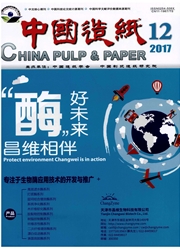

 中文摘要:
中文摘要:
以漂白硫酸盐桉木浆纤维为原料,进行TEMPO氧化预处理,再采用均质法和超声法及二者结合法分别制备出纳米纤丝纤维素(Nanofibrillated Cellulose,NFC),再经溶液浇铸法制备纳米纸。重点探讨了不同制备方法对NFC特性及其纳米纸性能的影响。结果表明,不同能耗下,超声2h、4h比均质2次、5次制备的NFC的透明性更好,长径比更大,直径更小,最小宽度可达19nm。工艺能耗低于20kWh时,与均质处理相比,超声处理强度(能耗)的增加更有利于纳米纸拉伸强度和透湿率的提高,同时超声2h、4h比均质2次、5次制备的NFC纳米纸的光学性能更好,其中超声4h制备的NFC得到的纳米纸拉伸强度与透光率最高,分别为155.8MPa、89.45%,优于一般的聚合物薄膜,有望应用于柔性显示电子器件的基材。
 英文摘要:
英文摘要:
NFC was prepared by using bleached krafteucalyptus pulp as new material, it was treated with TEMPO oxidation process at first, then fibrillated by homogenizing or ultrasonic method, finally the nanopaper made of the NFC was fabricated by solution casting method. The effects of different preparation methods on the properties of NFC and its nanopaper were discussed. The results showed that under different energy consumption, NFC prepared by uhrasonic treatment 2 h and 4 h had better transparency, higher length to diameter ratio and smaller diameter than that prepared by homogenizing 2 times and 5 times, the smallest width of the fibril was only 19 nm. Compared with homogeni- zing treatment, the increase of ultrasonic treatment intensity ( energy consumption) was more advantageous to improve the tensile strength and water vapor permeability of the nanopaper when process energy consumption was lower than 20 kWh, moreover, the nanopaper prepared by ultrasonic 2 h and 4 h showed better optical properties than homogenizing 2 times and 5 times, the highest tensile strength and light transmit- tance of nanopaper was found by ultrasonic treatment 4 h, which were 155.8 MPa and 89.45% respectively and superior to the ordinary polymer film, it was expected to be applied to the substrate of flexible display electronic devices.
 同期刊论文项目
同期刊论文项目
 同项目期刊论文
同项目期刊论文
 期刊信息
期刊信息
